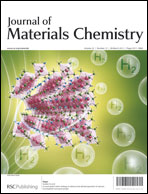A detailed model study has shown that thin film morphology and bulk-heterojunction solar cell performance can be significantly improved by systematic tuning of the surface energy of the conjugated donor polymer through side-chain functionalization. Thiophene-flanked diketopyrrolopyrrole (DPP) moieties with different contents of cyanohexane side chains were incorporated into three low band-gap conjugated copolymers (PIDTDPP1, PIDTDPP2 and PIDTDPP3) consisting of indacenodithiophene (IDT) donors and DPP acceptors. The resulting polymers possessed good solubility in common organic solvents and showed similar energy levels, bandgaps, and hole mobilities. However, the introduction of cyano groups onto the terminal of side-chains significantly changed their surface energy. Topographical images obtained from atomic force microscopy (AFM) proved that a better matched surface energy between polymer and PC71BM had led to enhanced miscibility, which resulted in better BHJ film morphology. Consistent with the surface energy enhancement, the performance of BHJ photovoltaic devices increased from 0.97% for PIDTDPP1, to 2.16% for PIDTDPP2 then to 3.67% for PIDTDPP3. These results clearly reveal that tuning surface energy is an effective way to improve the morphology of the BHJ active layer and efficiency of the photovoltaic device.

You have access to this article
 Please wait while we load your content...
Something went wrong. Try again?
Please wait while we load your content...
Something went wrong. Try again?


 Please wait while we load your content...
Please wait while we load your content...